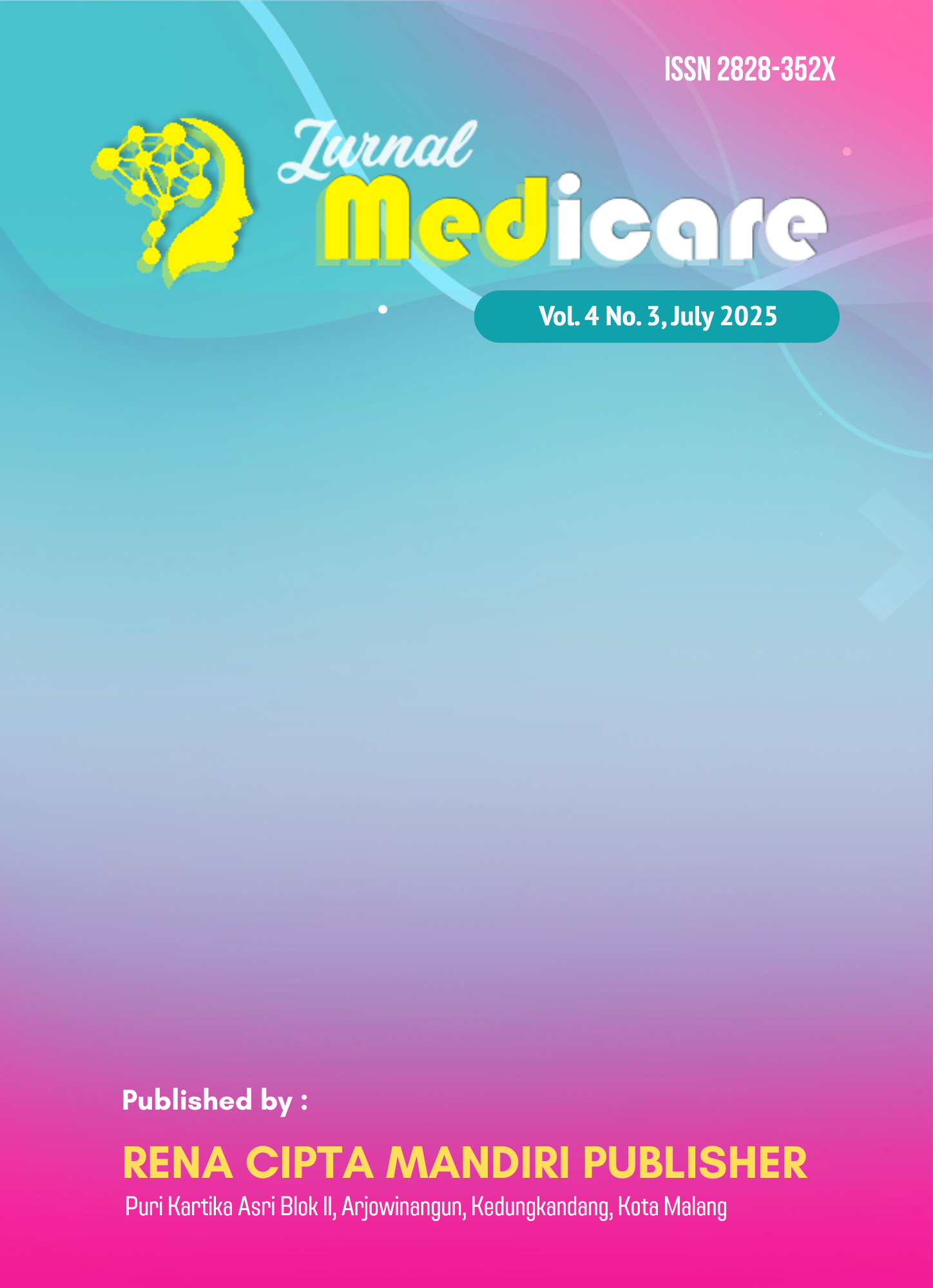ANALYSIS OF ENVIRONMENTAL FACTORS ON HUMAN SPERM VIABILITY IN MODERN CLINICAL REPRODUCTION LABORATORY
DOI:
https://doi.org/10.62354/jurnalmedicare.v4i3.216Keywords:
ART, IVF, ICSI, laboratory environment, sperm viabilityAbstract
This study discusses the main influence of environmental factors on sperm viability in modern clinical reproductive laboratories, which is a crucial component in successful fertilization because only live and good quality sperm are capable of fertilizing an egg. Sperm are known to be very sensitive to environmental disturbances. Based on a review of the latest scientific literature (2020–2025), this study emphasizes the importance of maintaining the incubation temperature at 37°C, the pH of the culture medium between 7.2–7.4, and regulating the concentration of CO₂ (5–7%) and O₂ (5%) gases in order to create optimal culture conditions. Imbalances such as temperature fluctuations, excessively high pH, the presence of volatile organic compounds (VOCs), and exposure to light—particularly blue light—have been shown to increase oxidative stress that adversely affects sperm viability. Therefore, laboratory optimization strategies such as the use of compartment incubators, automated CO₂ regulation systems, fast and gentle sample handling, and protection from excessive light exposure are essential to enhance the success of assisted reproductive (ART) technologies such as IVF and ICSI.
Downloads
References
Bodis, J. (2020). How to Reduce the Potential Harmful Effects of Light on Blastocyst Development during IVF. Med Princ Pract.
Boitrelle, F. (2021). The Sixth Edition of the WHO Manual for Human Semen Analysis: A Critical Review and SWOT Analysis. Andrology.
Choudhary, M. S. (2020). Effect of Temperature Fluctuations on Human Sperm Function During In Vitro Handling. Andrologia.
Collections, C. (2023). CO₂ incubation and cell culture media. UK Health Security Agency.
De Geyter, C. e. (2021). Quality management and training in human IVF laboratories: best practices and recommendations. Human Reproduction Open.
Dubey, A. K. (2021). Inferences of Carbon Dioxide in Present-Day Cell Culture Systems: An Unacknowledged Problem and Perspectives. Austin Therapeutics.
Ergun, Y. (2022). The Assessment of Purity Level of CO2 Used in Horizontal Incubators and The Effect of Additional In-Line Filters on Embryo Development. American Journal of Biomedical Science & Research.
Fitri. (2020). Pengaruh Suhu dan Waktu Penanganan Terhadap Kualitas Sperma pada Laboratorium Reproduksi Berbantu. Jurnal Bioteknologi dan Reproduksi.
Guo, S.-W. (2020). Reply: Possible treatment associated with cancer in endometriosis. Human Reproduction Update.
Harada, T. (2021). Effects of temperature fluctuations on sperm viability and motility. Reproductive Medicine and Biology.
Hidayat, W. &. (2020). Design and Implementation of an Automated CO₂ Incubator for Cell Culture Applications. Journal of Medical Signals & Sensors.
J Maia, B. F. (2020). Optimizing the laboratory environment for human embryo culture. Human Reproduction Update.
Klau, M. K. (2024). Efek Pemberian Suplementasi Kombinasi Vitamin C dan Albumin Terhadap Viabilitas Spermatozoa dalam Proses Sentrifugasi (Studi In Vitro. Medical Scope Journal.
Levy, N. e. (2020). Continuous professional development in ART laboratories: Impact on laboratory performance and patient outcomes. Journal of Assisted Reproductio nd Genetics.
Maharajan, L. (2021). Sperm preparedness and adaptation to osmotic and pH stressors relate to functional competence of sperm in Bos taurus. Scientific Reports.
Matsuura. (2021). Effect of Cold Shock on Human Sperm Viability and Membrane Integrity. Fertility and Sterility.
Mauchart, P. (2021). Oxidative Stress in Assisted Reproductive Techniques, with a Focus on an Underestimated Risk Factor. journal on molecular biology.
Murayama, Y. (2022). Temperature Dynamics in Early Pregnancy: Implications for Improving In Vitro Fertilization Outcomes. Applied Sciences.
Nugroho, Y. &. (2021). Pengaruh Kondisi Lingkungan Laboratorium terhadap Kualitas Sperma pada Program IVF. Jurnal Reproduksi dan Endokrinologi, 15-22.
Organization, W. H. (2021). WHO laboratory manual for the examination and processing of human semen (6th ed.). Geneva: World Health Organization.
Rahman. (2020). Pengaruh Kualitas Udara di Laboratorium Terhadap Proses Kultur Sel.Jurnal Kesehatan Lingkungan.
Rienzi, L. E. (2022). Laboratory personnel training and quality control in assisted reproductive technology: Ensuring optimal outcomes. Reproductive Biology and Endocrinology.
Sansone, A. (2021). Cultured human sperm under visible light stress: Role of ROS production and antioxidant defenses. Andrology.
Santoso. (2021). Analisis Faktor Lingkungan pada Gedung Laboratorium Klinik di Indonesia. Jurnal Sanitasi dan Higiene Indonesia.
Santoso, F. (2020). Pengaruh pH media kultur terhadap motilitas dan viabilitas sperma manusia di laboratorium reproduksi. Jurnal Bioteknologi dan Reproduksi, 45-52.
Sciorio, R. (2023). Comparison of the development of human embryos cultured in either an EmbryoScope or benchtop incubator. Journal of Assisted Reproduction and Genetics.
Shari, A. (2024). Seleksi Spermatozoa Pada Fertilisasi In Vitro (IVF). Indonesian Journal of Health Science.
Sunde, A. (2021). Culture Media and Embryo Culture. In K. Lundin, Manual of Embryo Culture in Human Assisted Reproduction. Cambridge University Press.
Wang, Y. (2025). Mechanisms of oxidative stress-induced sperm dysfunction. Endocrinology.
Wibowo, A. &. (2021). Pengaruh Stres Oksidatif terhadap Viabilitas Sperma dalam Proses IVF. Jurnal Kedokteran dan Kesehatan Indonesia, 45-53.
Downloads
Published
How to Cite
Issue
Section
License
Copyright (c) 2025 Jurnal Medicare

This work is licensed under a Creative Commons Attribution-ShareAlike 4.0 International License.
Licensing for Data Publication
-
Open Data Commons Attribution License, http://www.opendatacommons.org/licenses/by/1.0/ (default)
-
Creative Commons CC-Zero Waiver, http://creativecommons.org/publicdomain/zero/1.0/
-
Open Data Commons Public Domain Dedication and Licence, http://www.opendatacommons.org/licenses/pddl/1-0/


















